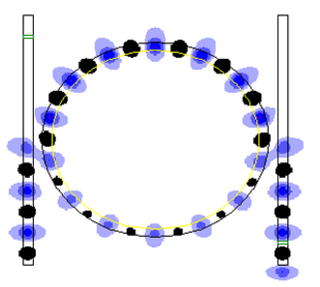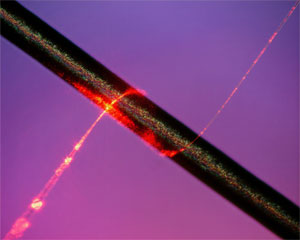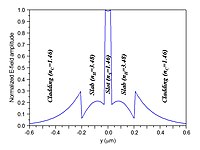
An optical ring resonator is a set of waveguides in which at least one is a closed loop coupled to some sort of light input and output. The concepts behind optical ring resonators are the same as those behind whispering galleries except that they use light and obey the properties behind constructive interference and total internal reflection. When light of the resonant wavelength is passed through the loop from the input waveguide, the light builds up in intensity over multiple round-trips owing to constructive interference and is output to the output bus waveguide which serves as a detector waveguide. Because only a select few wavelengths will be at resonance within the loop, the optical ring resonator functions as a filter. Additionally, as implied earlier, two or more ring waveguides can be coupled to each other to form an add/drop optical filter.
In optics, an anti-resonant reflecting optical waveguide (ARROW) is a waveguide that uses the principle of thin-film interference to guide light with low loss. It is formed from an anti-resonant Fabry–Pérot reflector. The optical mode is leaky, but relatively low-loss propagation can be achieved by making the Fabry–Pérot reflector of sufficiently high quality or small size.

An optical microcavity or microresonator is a structure formed by reflecting faces on the two sides of a spacer layer or optical medium, or by wrapping a waveguide in a circular fashion to form a ring. The former type is a standing wave cavity, and the latter is a traveling wave cavity. The name microcavity stems from the fact that it is often only a few micrometers thick, the spacer layer sometimes even in the nanometer range. As with common lasers, this forms an optical cavity or optical resonator, allowing a standing wave to form inside the spacer layer or a traveling wave that goes around in the ring.
An optical waveguide is a physical structure that guides electromagnetic waves in the optical spectrum. Common types of optical waveguides include optical fiber waveguides, transparent dielectric waveguides made of plastic and glass, liquid light guides, and liquid waveguides.

Silicon photonics is the study and application of photonic systems which use silicon as an optical medium. The silicon is usually patterned with sub-micrometre precision, into microphotonic components. These operate in the infrared, most commonly at the 1.55 micrometre wavelength used by most fiber optic telecommunication systems. The silicon typically lies on top of a layer of silica in what is known as silicon on insulator (SOI).

In optics, a supercontinuum is formed when a collection of nonlinear processes act together upon a pump beam in order to cause severe spectral broadening of the original pump beam, for example using a microstructured optical fiber. The result is a smooth spectral continuum. There is no consensus on how much broadening constitutes a supercontinuum; however researchers have published work claiming as little as 60 nm of broadening as a supercontinuum. There is also no agreement on the spectral flatness required to define the bandwidth of the source, with authors using anything from 5 dB to 40 dB or more. In addition the term supercontinuum itself did not gain widespread acceptance until this century, with many authors using alternative phrases to describe their continua during the 1970s, 1980s and 1990s.

A subwavelength-diameter optical fibre is an optical fibre whose diameter is less than the wavelength of the light being propagated through it. An SDF usually consists of long thick parts at both ends, transition regions (tapers) where the fibre diameter gradually decreases down to the subwavelength value, and a subwavelength-diameter waist, which is the main acting part. Due to such a strong geometrical confinement, the guided electromagnetic field in an SDF is restricted to a single mode called fundamental.
Michal Lipson is an American physicist known for her work on silicon photonics. Lipson was named a 2010 MacArthur Fellow for contributions to silicon photonics especially towards enabling GHz silicon active devices. Until 2014, she was the Given Foundation Professor of Engineering at Cornell University in the school of electrical and computer engineering and a member of the Kavli Institute for Nanoscience at Cornell. She is now the Eugene Higgins Professor of Electrical Engineering at Columbia University. In 2009 she co-founded the company PicoLuz, which develops and commercializes silicon nanophotonics technologies. In 2019, she co-founded Voyant Photonics, which develops next generation lidar technology based on silicon photonics. In 2020 Lipson was elected the 2021 Vice President of The Optical Society and will serve as OSA President in 2023.

A photonic metamaterial (PM), also known as an optical metamaterial, is a type of electromagnetic metamaterial, that interacts with light, covering terahertz (THz), infrared (IR) or visible wavelengths. The materials employ a periodic, cellular structure.
A metamaterial absorber is a type of metamaterial intended to efficiently absorb electromagnetic radiation such as light. Furthermore, metamaterials are an advance in materials science. Hence, those metamaterials that are designed to be absorbers offer benefits over conventional absorbers such as further miniaturization, wider adaptability, and increased effectiveness. Intended applications for the metamaterial absorber include emitters, photodetectors, sensors, spatial light modulators, infrared camouflage, wireless communication, and use in solar photovoltaics and thermophotovoltaics.
Silicon Photonics Link is a silicon-based optical data connection developed by Intel Corporation which uses silicon photonics and hybrid silicon laser, it provides 50 Gbit/s bandwidth. Intel expected the technology to be in products by 2015.
Optofluidics is a research and technology area that combines the advantages of fluidics and optics. Applications of the technology include displays, biosensors, lab-on-chip devices, lenses, and molecular imaging tools and energy.
A plasmonic metamaterial is a metamaterial that uses surface plasmons to achieve optical properties not seen in nature. Plasmons are produced from the interaction of light with metal-dielectric materials. Under specific conditions, the incident light couples with the surface plasmons to create self-sustaining, propagating electromagnetic waves known as surface plasmon polaritons (SPPs). Once launched, the SPPs ripple along the metal-dielectric interface. Compared with the incident light, the SPPs can be much shorter in wavelength.
In physics, a high contrast grating is a single layer near-wavelength grating physical structure where the grating material has a large contrast in index of refraction with its surroundings. The term near-wavelength refers to the grating period, which has a value between one optical wavelength in the grating material and that in its surrounding materials.

Roberto Morandotti is a physicist and full Professor, working in the Energy Materials Telecommunications Department of the Institut National de la Recherche Scientifique. The work of his team includes the areas of integrated and quantum photonics, nonlinear and singular optics, as well as terahertz photonics.

A hybrid plasmonic waveguide is an optical waveguide that achieves strong light confinement by coupling the light guided by a dielectric waveguide and a plasmonic waveguide. It is formed by separating a medium of high refractive index from a metal surface by a small gap.

Plasmonics or nanoplasmonics refers to the generation, detection, and manipulation of signals at optical frequencies along metal-dielectric interfaces in the nanometer scale. Inspired by photonics, plasmonics follows the trend of miniaturizing optical devices, and finds applications in sensing, microscopy, optical communications, and bio-photonics.

An electromagnetic metasurface refers to a kind of artificial sheet material with sub-wavelength thickness. Metasurfaces can be either structured or unstructured with subwavelength-scaled patterns in the horizontal dimensions.
Joyce Poon is Professor of Electrical and Computer Engineering at the University of Toronto and Director of the Max Planck Institute of Microstructure Physics, where her research focuses on developing new optical devices for applications in neurotechnology. She is also an honorary professor at the Technical University of Berlin. She is a Fellow of The Optical Society, and has been serving as a Director-At-Large for the society since January 2021.
In photonics, a meta-waveguide is a physical structures that guides electromagnetic waves with engineered functional subwavelength structures. Meta-waveguides are the result of combining the fields of metamaterials and metasurfaces into integrated optics. The design of the subwavelength architecture allows exotic waveguiding phenomena to be explored.












